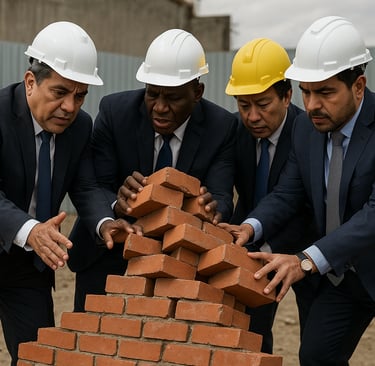A BRICS Too Far
AMERICAS
Philip Morande
9/7/20252 min read
The BRICS group—now commonly referred to as BRICS+—originally brought together Brazil, Russia, India, China, and South Africa. It has recently expanded to include Egypt, Ethiopia, Iran, the United Arab Emirates, and several associated states. What stands out about this coalition is not only its geographic reach across three continents, but also the sheer scale of its population: roughly 4.45 billion people, or about 56% of the world’s total. Among them are the two most populous nations on Earth. In terms of purchasing power parity (PPP), the bloc accounts for around 44% of global GDP. Together, these countries represent a major geopolitical force—though, with the notable exception of China, their influence is largely collective rather than individual.
The broader aim of BRICS+ is to position itself as a coalition capable of challenging the dominance of the U.S. dollar, countering Washington’s global influence—particularly through economic and financial sanctions—and offering credible alternatives to institutions like the World Bank and the International Monetary Fund. Initiatives such as the New Development Bank (NDB), the Contingent Reserve Arrangement (CRA), and the BRICS Multilateral Guarantee (BMG) reflect a concerted effort to reduce dependence on the Western-led financial system.
However, beyond the obvious financial and economic questions, there is a deeper cultural and institutional dimension—often overlooked—that may hinder the bloc’s development: the absence of basic guarantees such as freedom of expression, legal certainty, and private property rights. Most BRICS+ countries lack the fundamental conditions that make nations attractive to foreign investors and multinational corporations. State intervention remains central to their economic systems, and many governments impose significant restrictions on individual freedoms. Without freedom of speech, creativity struggles to flourish. In several cases, ruling elites have expropriated private assets for political reasons—a pattern seen in Russia, China, and historically in Cuba, Bolivia, and Belarus.
Add to this a culture of bureaucracy and systemic corruption, and doing business becomes significantly more complicated. While it is possible to operate in such environments, the costs and risks rise sharply, exacerbated by weak institutions that fail to guarantee basic economic rights. These issues are widespread across the BRICS+ landscape. One only needs to look at the plight of white minorities in South Africa, the tight nexus between oligarchs and President Putin, or Xi Jinping’s ongoing campaign to root out entrenched corruption in China. And the list goes on.
The challenges are real—and so are the internal weaknesses that could prevent this alliance from reaching its full potential. Does that mean the BRICS+ project is bound to fail? Not necessarily. The bloc’s economic and demographic weight is undeniable, and some member countries have made significant technological and even military investments. These factors could support the development of a trade and financial model based on their own currencies, despite the fact that over 80% of global reserves are still held in U.S. dollars.
Could the United States and Europe lose some of their global dominance? That will depend largely on how they respond. But that, of course, is a discussion for another column.


